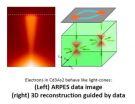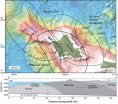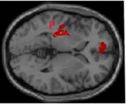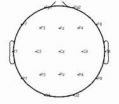(Press-News.org) As smartphones get smarter and computers compute faster, researchers actively search for ways to speed up the processing of information. Now, scientists at Princeton University have made a step forward in developing a new class of materials that could be used in future technologies.
They have discovered a new quantum effect that enables electrons — the negative-charge-carrying particles that make today's electronic devices possible — to dash through the interior of these materials with very little resistance.
The discovery is the latest chapter in the story of a curious material known as a "topological insulator," in which electrons whiz along the surface without penetrating the interior. The newest research indicates that these electrons also can flow through the interior of some of these materials.
"With this discovery, instead of facing the challenge of how to use only the electrons on the surface of a material, now you can just cut the material open and you have light-like electrons flowing in three dimensions inside the materials," said M. Zahid Hasan, a professor of physics at Princeton, who led the discovery.
The finding was conducted by a team of scientists from the United States, Taiwan, Singapore, Germany and Sweden and published in two papers in the journal Nature Communications. The first paper, published May 7, demonstrates that fast electrons can flow in the interior of crystals made from cadmium and arsenic, or cadmium arsenide. The second paper, published May 12, explores fast electrons in a material made from the elements bismuth and selenium.
In most materials, including copper and other metals that conduct electricity, electrons navigate an obstacle course of microscopic outcroppings, ledges and other imperfections that obstruct the tiny particles and send them scattering in the wrong directions. This causes resistance and the conversion of electrical current into heat, which is why electronic appliances become warm during use.
In topological insulators and the new class of materials the Princeton researchers studied, the unique properties of the atoms combine to create quantum effects that coax electrons into acting similar to a light wave instead of like individual particles. These waves can weave around and dodge — and even move through — barriers that would typically stop most electrons. These properties were theoretically proposed by Charles Kane and a team at the University of Pennsylvania from 2005 to 2007 and first observed experimentally in solid materials by the Hasan group in 2007 and 2008.
In 2011, the Hasan group detected this fast electron-flow in the interior of a material made from combining several elements — bismuth, thallium, sulfur and selenium. The results were published in the journal Science.
In the new study in cadmium arsenide, the electrons have an average velocity that is 10,000 times more than that of the previous bismuth-based materials identified by the group. "This is a big deal," Hasan said. "It means the electrons can flow quite easily in the material and many more exotic quantum effects can now be studied. That just wasn't possible in the past."
The most promising application for these materials may be for a proposed "topological quantum computer" based on novel electronics that would use a property of electrons known as "spin" to do calculations and transmit information.
The quantum behavior in this new class of materials has led them to be called "topological Dirac semi-metals" in reference to English quantum physicist and 1933 Nobel Prize winner Paul Dirac, who noted that electrons could behave like light. Semi-metals that are "topological" are ones that retain their spatial electronic properties — and their speedy electrons — even when deformed by certain types of stretching and twisting.
The speeds achieved by these electrons have led to comparisons to another novel electronic material, graphene. The new class of materials has the potential to be superior to graphene in some aspects, Hasan said, because graphene is a single layer of atoms in which electrons can flow only in two dimensions. Cadmium arsenide permits electrons to flow in three dimensions.
The new study redefines what it means to be a topological material, according to Su-Yang Xu, a graduate student in Hasan's lab and co-first author of the May 7 paper with postdoctoral research associate Madhab Neupane at Princeton and Raman Sankar of National Taiwan University.
"The term topological insulator is now quite famous, and the yet term 'insulator' means that there are no electrons flowing in the bulk of the material," Xu said. "Our study shows that electrons are flowing in the bulk of the material, so clearly cadmium arsenide is not an insulator, but it is still topological in nature, so this is a totally new type of quantum matter," he said.
The team made the discovery using a technique called angle-resolved photoemission spectroscopy. The researchers shined a very powerful X-ray beam — using a particle accelerator at the Advanced Light Source at Lawrence Berkeley National Laboratory — onto the surface of the material then monitored the electrons as they were knocked out of the interior.
"When the electron comes out, we measure its energy and velocity, and what we found is that electrons coming out of the cadmium arsenide had measurements that were similar to what is seen in particles that are massless," Neupane said.
In the second paper in Nature Communications, Neupane and co-authors presented a model for controlling the spin direction of the electron particles in a different material, bismuth selenide.
"The Princeton group showed in exquisite details that electrons in certain solids obey the three dimensional massless Dirac equation," said Patrick Lee, a professor of physics at the Massachusetts Institute of Technology who was not involved in the work. "While predicted by theoretical calculations, this behavior has never been seen before in real materials until this past year. This work adds greatly to the ongoing excitement of how topology can impact electronic states in real materials."
INFORMATION:
The first study, "Observation of a three-dimensional topological Dirac semimetal phase in high-mobility Cd3As2" appeared in the journal Nature Communications on May 7, 2014. The co-first-authors were Madhab Neupane and Su-Yang Xu of Princeton University and Raman Sankar of National Taiwan University. Additional researchers at Princeton who contributed to the work were graduate students Nasser Alidoust and Ilya Belopolski, and postdoctoral research associates Guang Bian and Chang Liu. The team also included Tay-Rong Chang of National Tsing Hua University in Taiwan; Horng-Tay Jeng of National Tsing Hua University and Academia Sinica in Taiwan; Hsin Lin of National University of Singapore; Arun Bansil of Northeastern University; and Fangcheng Chou of National Taiwan University.
The second study, "Observation of a quantum-tunnelling-modulated spin texture in ultrathin topological insulator Bi2Se3 films," appeared in the journal Nature Communications on May 12, 2014. The first author was Madhab Neupane. Co-authors at Princeton were Su-Yang Xu, Nasser Alidoust, Ilya Belopolski, Chang Liu and Guang Bian. Also on the team were Anthony Richardella, Duming Zhang and Nitin Samarth of Pennsylvania State University; Jaime Sánchez-Barriga, Dmitry Marchenko, Oliver Rader and Andrei Varykhalov of Helmholtz Centre Berlin for Materials and Energy; Mats Leandersson and Thiagarajan Balasubramanian of MAX-lab, Sweden; Tay-Rong Chang of National Tsing Hua University in Taiwan; Horng-Tay Jeng of National Tsing Hua University and Academia Sinica in Taiwan; Hsin Lin of National University of Singapore, and Susmita Basak and Arun Bansil of Northeastern University.
Primary funding for both studies was provided by the U.S. Department of Energy's Office of Basic Energy Sciences.
Fast and curious: Electrons hurtle into the interior of a new class of quantum materials
2014-05-16
ELSE PRESS RELEASES FROM THIS DATE:
Researchers call for better ocean stewardship
2014-05-16
FORT LAUDERDALE-DAVIE, Fla. – It has been said that we know more about the surface of the moon than we do about our own planet's oceans. That especially applies to the deepest parts of our oceans – depths that are 200 meters or deeper.
Researchers from organizations around the world who specialize in studying and exploring the deepest regions of our oceans have come together to pen a cautionary tale that urges we take a critical look at how we're treating our seas.
"We need to consider the common heritage of mankind - when do we have the right to take something that ...
Molecules involved in rheumatoid arthritis angiogenesis identified
2014-05-16
Two protein molecules that fit together as lock and key seem to promote the abnormal formation of blood vessels in joints affected by rheumatoid arthritis, according to researchers at the University of Illinois at Chicago College of Medicine, who found that the substances are present at higher levels in the joints of patients affected by the disease.
Their results are reported in the journal Annals of the Rheumatic Diseases.
"Our results show, for the first time, that these two proteins – a receptor and its corresponding binding protein - play a key role in the progression ...
US foreclosures drive up suicide rate
2014-05-16
HANOVER, N.H. – May 16, 2014 – The recent U.S. foreclosure crisis contributed significantly to the nation's jump in suicides, independent of other economic factors associated with the Great Recession, according to a study by Dartmouth and Purdue professors publishing Monday.
The study, publishing in the June issue of the American Journal of Public Health and available online now, is the first to ever show a correlation between foreclosure and suicide rates.
The authors analyzed state-level foreclosure and suicide rates from 2005 to 2010. During that period, the U.S. ...
Analysis finds wide variation in lung cancer rates globally
2014-05-16
ATLANTA – May 16, 2014—The only recent comprehensive analysis of lung cancer rates for women around the world finds lung cancer rates are dropping in young women in many regions of the globe, pointing to the success of tobacco control efforts. However, rates continue to increase among older women in many countries, indicating a need for more concentrated efforts to initiate or expand comprehensive tobacco control programs across the globe to curtail future tobacco-related lung cancer deaths. The study is published early online in Cancer Epidemiology, Biomarkers & Prevention.
Lung ...
On the shoulder of a giant: Precursor volcano to the island of O'ahu discovered
2014-05-16
Researchers from the University of Hawai'i – Mānoa (UHM), Laboratoire des Sciences du Climat et de L'Environment (France), and Monterey Bay Aquarium Research Institute recently discovered that O'ahu actually consists of three major Hawaiian shield volcanoes, not two, as previously thought. The island of O'ahu, as we know it today, is the remnants of two volcanoes, Wai'anae and Ko'olau. But extending almost 100 km WNW from Ka'ena Point, the western tip of the island of O'ahu, is a large region of shallow bathymetry, called the submarine Ka'ena Ridge. It is that region ...
Neuronal activation by acupuncture at Yongquan and sham acupoints for DOC: A PET study
2014-05-16
Acupuncture is a traditional Chinese medicine technique that is often used to help improve the level of consciousness in patients with disorder of consciousness (DOC). However, the responses to stimulation of acupoints in patients with DOC are not fully understood. Hao Zhang and colleagues from China Rehabilitation Research Center found that acupuncture at the Yongquan acupoints induced stronger neuronal activity than acupuncture at the sham acupoints shown on positron emission tomography (PET). These researchers believe that acupuncture at the Yongquan acupoints may increase ...
Effect of repeated-pulse transcranial magnetic stimulation at the Guangming point on EEGs
2014-05-16
In a recent study reported in the Neural Regeneration Research (Vol. 9, No. 5, 2014), repeated-pulse transcranial magnetic stimulation was administered to healthy people at the left Guangming (GB37) and a mock point, and calculated the sample entropy of electroencephalogram signals using nonlinear dynamics. Additionally, researchers compared electroencephalogram sample entropy of signals in response to visual stimulation before, during, and after repeated-pulse transcranial magnetic stimulation at the Guangming. Results showed that repeated-pulse transcranial magnetic stimulation ...
New treatment targeting versatile protein may protect brain cells in Parkinson's disease
2014-05-16
In Parkinson's disease (PD), dopamine-producing nerve cells that control our movements waste away. Current treatments for PD therefore aim at restoring dopamine contents in the brain. In a new study from Lund University, researchers are attacking the problem from a different angle, through early activation of a protein that improves the brain's capacity to cope with a host of harmful processes. Stimulating the protein, called Sigma-1 receptor, sets off a battery of defence mechanisms and restores lost motor function. The results were obtained in mice, but clinical trials ...
Domesticated animals provide vital link to emergence of new diseases
2014-05-16
Research at the University of Liverpool suggests pets and other domesticated animals could provide new clues into the emergence of infections that can spread between animals and humans.
The study showed that the number of parasites and pathogens shared by humans and animals is related to how long animals have been domesticated.
The findings suggest that although wild animals may be important for the transmission of new diseases to humans, humanity's oldest companions – livestock and pets such as cattle and dogs provide the vital link in the emergence of new diseases.
Using ...
Tricking the uncertainty principle
2014-05-16
Caltech researchers have found a way to make measurements that go beyond the limits imposed by quantum physics.
Today, we are capable of measuring the position of an object with unprecedented accuracy, but quantum physics and the Heisenberg uncertainty principle place fundamental limits on our ability to measure. Noise that arises as a result of the quantum nature of the fields used to make those measurements imposes what is called the "standard quantum limit." This same limit influences both the ultrasensitive measurements in nanoscale devices and the kilometer-scale ...




